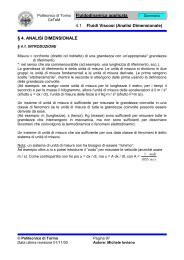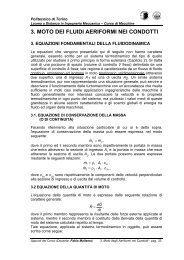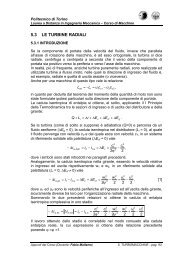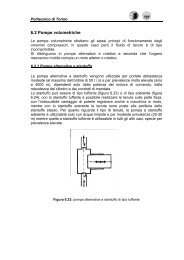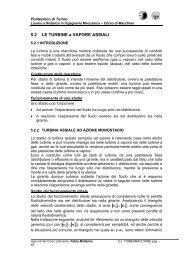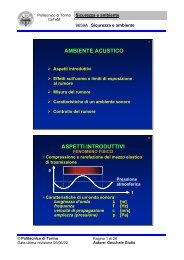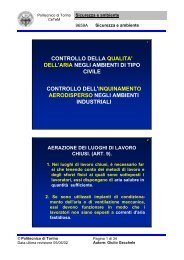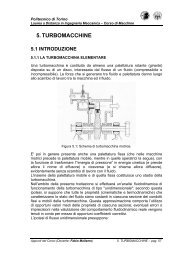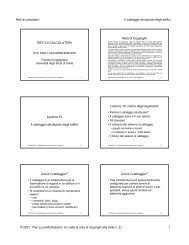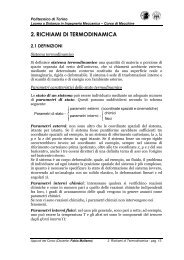Ruote dentate - Corsi di Laurea a Distanza - Politecnico di Torino
Ruote dentate - Corsi di Laurea a Distanza - Politecnico di Torino
Ruote dentate - Corsi di Laurea a Distanza - Politecnico di Torino
You also want an ePaper? Increase the reach of your titles
YUMPU automatically turns print PDFs into web optimized ePapers that Google loves.
<strong>Politecnico</strong> <strong>di</strong> <strong>Torino</strong><br />
CeTeM<br />
Elementi Costruttivi delle Macchine<br />
Dispense integrative sulle ruote<br />
<strong>dentate</strong><br />
I raggi primitivi <strong>di</strong> taglio R01, R02 possono anche essere raggi <strong>di</strong> lavoro delle due ruote<br />
accoppiate: SI se S01 e S02 rispettano la con<strong>di</strong>zione <strong>di</strong> corretto ingranamento. Cioè se è:<br />
⎛π π<br />
2x tanα ⎞<br />
m<br />
⎛<br />
2x tanα<br />
⎞<br />
⎜ + + + m = πm<br />
1 0 0 2 0 0 0<br />
2<br />
⎟ ⎜<br />
2<br />
⎟ , e quin<strong>di</strong> per x1 + x2 = 0. Verifica automatica<br />
⎝ ⎠ ⎝ ⎠<br />
mentre per ruote <strong>di</strong> serie (x1 = x2 = 0) e quando x2 = - x1. Allora R1 = R01, R2 = R02, α=α0.<br />
Se invece x1 + x2 0: R1 R01, R2 R02, α α0 il problema effettivo del progetto (trovare<br />
i= R1+ R2)<br />
si risolve determinando dapprima α me<strong>di</strong>ante la con<strong>di</strong>zione <strong>di</strong> corretto<br />
ingranamento ideale.<br />
S<br />
r<br />
S*<br />
r*<br />
2 *<br />
⎡S⎤ 01<br />
r* = R01,* s = S01, ϑ* = α0<br />
ricavo S1 = R1 ⎢ + 2 ( invα0 −invα)<br />
R<br />
⎥<br />
⎣ 01<br />
⎦<br />
Zm⎡<br />
1 ⎛π⎞ 2<br />
S1 = 2 1tan 0 0<br />
2<br />
⎢⎜ + x α m<br />
2<br />
⎟<br />
⎣⎝ ⎠ Zm 1 0<br />
⎤<br />
+ 2(<br />
invα0 −invα)<br />
⎥<br />
⎦<br />
⎡⎛π⎞ ⎤<br />
S1 = m⎢⎜ + 2x1tanα0⎟+ Z 1( invα0−invα) 2<br />
⎥<br />
⎣⎝ ⎠<br />
⎦<br />
Dalla = + ( invϑ − invϑ)<br />
, riscritta considerando r R ( s s ϑ α)<br />
Con analoghi ragionamenti per la ruota 2:<br />
⎡⎛π⎞ ⎤<br />
S2 = m⎢⎜ + 2x2 tanα0⎟+<br />
Z 2( invα0−invα) 2<br />
⎥<br />
⎣⎝ ⎠<br />
⎦<br />
La con<strong>di</strong>zione S1 + S2 = πm porta a scrivere:<br />
( ) ( ) ( )<br />
⎡mπ+ 2 x + x tan α+ Z + Z ⋅ invα − invα ⎤ = πm<br />
⎣ 1 2 1 2 0 ⎦<br />
x1+ x2<br />
da cui invα= invα<br />
+ 2 tanα<br />
Z + Z<br />
0 0<br />
1 2<br />
© <strong>Politecnico</strong> <strong>di</strong> <strong>Torino</strong> Pagina 8 <strong>di</strong> 19<br />
Data ultima revisione 26/11/03 Autore: Giovanni Roccati<br />
= = = ;<br />
1 1 ,<br />
NOTI X1, X2, α0, Z1, Z2 si ricava inv(α). Noto inv(α), per intersezione con il <strong>di</strong>agramma<br />
della funzione α<br />
Noti R01, ñ1 = R01cosα0 R1 = ñ1 / cosα, analog. R2 = ñ2 / cosα; m = m0cosα0 / cosα;<br />
i=R1+R2<br />
In fase <strong>di</strong> taglio definiti i raggi <strong>di</strong> piede Rp1, Rp2; volendo un gioco ra<strong>di</strong>ale g (normalmente<br />
0,25 m0) fra testa <strong>di</strong> un dente e piede del dente della ruota coniugata si dovrà considerare<br />
la relazione: i= Rp1+ g + Rt2 = Rp2 + g+ Rt1;<br />
da cui Rt1 = i −g− Rp2; Rt2 = i −g −<br />
Rp1.



